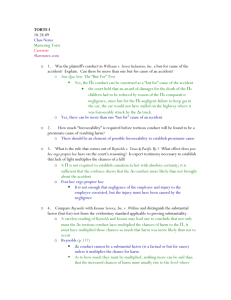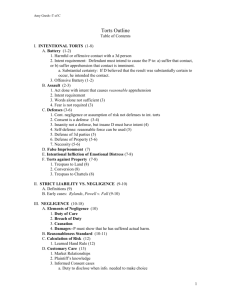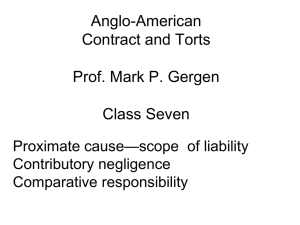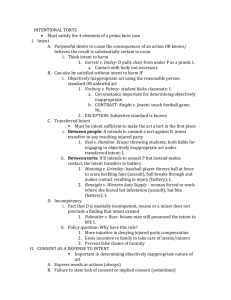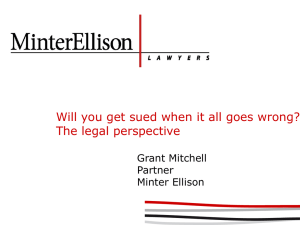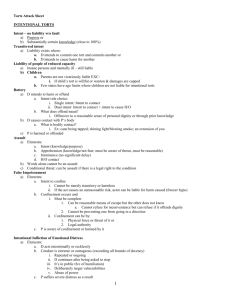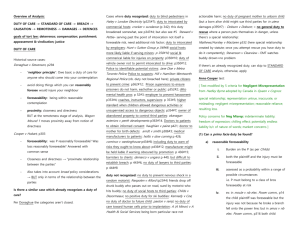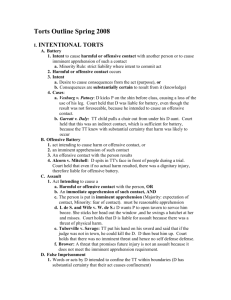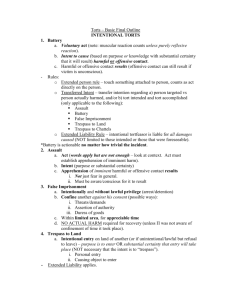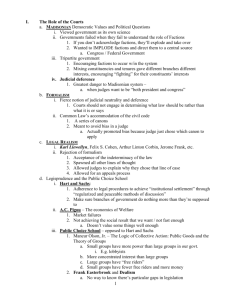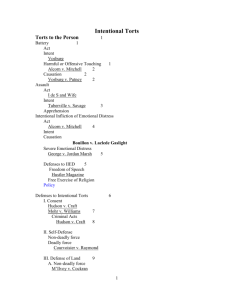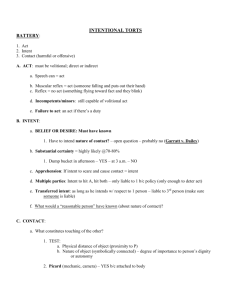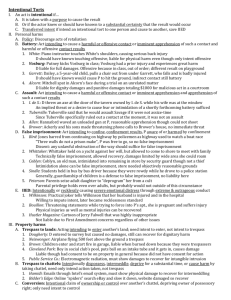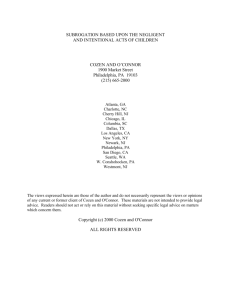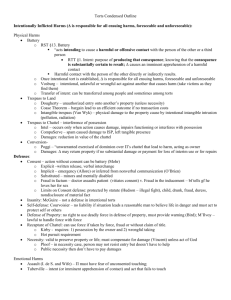Breach of duty – effected by negligent conduct
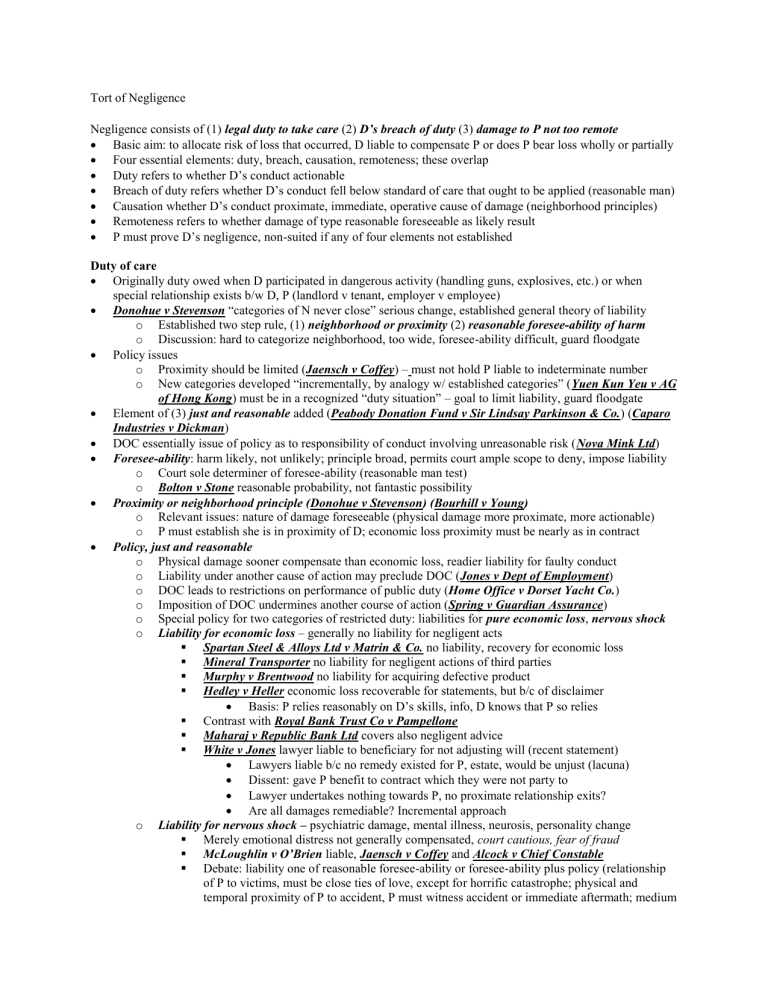
Tort of Negligence
Negligence consists of (1) legal duty to take care (2) D’s breach of duty (3) damage to P not too remote
Basic aim: to allocate risk of loss that occurred, D liable to compensate P or does P bear loss wholly or partially
Four essential elements: duty, breach, causation, remoteness; these overlap
Duty refers to whether D’s conduct actionable
Breach of duty refers whether D’s conduct fell below standard of care that ought to be applied (reasonable man)
Causation whether D’s conduct proximate, immediate, operative cause of damage (neighborhood principles)
Remoteness refers to whether damage of type reasonable foreseeable as likely result
P must prove D’s negligence, non-suited if any of four elements not established
Duty of care
Originally duty owed when D participated in dangerous activity (handling guns, explosives, etc.) or when special relationship exists b/w D, P (landlord v tenant, employer v employee)
Donohue v Stevenson “categories of N never close” serious change, established general theory of liability o
Established two step rule, (1) neighborhood or proximity (2) reasonable foresee-ability of harm o Discussion: hard to categorize neighborhood, too wide, foresee-ability difficult, guard floodgate
Policy issues o Proximity should be limited ( Jaensch v Coffey ) – must not hold P liable to indeterminate number o New categories developed “incrementally, by analogy w/ established categories” (
Yuen Kun Yeu v AG of Hong Kong ) must be in a recognized “duty situation” – goal to limit liability, guard floodgate
Element of (3) just and reasonable added ( Peabody Donation Fund v Sir Lindsay Parkinson & Co.
) ( Caparo
Industries v Dickman )
DOC essentially issue of policy as to responsibility of conduct involving unreasonable risk ( Nova Mink Ltd )
Foresee-ability : harm likely, not unlikely; principle broad, permits court ample scope to deny, impose liability o Court sole determiner of foresee-ability (reasonable man test) o
Bolton v Stone reasonable probability, not fantastic possibility
Proximity or neighborhood principle (Donohue v Stevenson) (Bourhill v Young) o Relevant issues: nature of damage foreseeable (physical damage more proximate, more actionable) o
P must establish she is in proximity of D; economic loss proximity must be nearly as in contract
Policy, just and reasonable o Physical damage sooner compensate than economic loss, readier liability for faulty conduct o Liability under another cause of action may preclude DOC ( Jones v Dept of Employment ) o
DOC leads to restrictions on performance of public duty ( Home Office v Dorset Yacht Co.
) o Imposition of DOC undermines another course of action ( Spring v Guardian Assurance ) o Special policy for two categories of restricted duty: liabilities for pure economic loss , nervous shock o Liability for economic loss – generally no liability for negligent acts
Spartan Steel & Alloys Ltd v Matrin & Co.
no liability, recovery for economic loss
Mineral Transporter no liability for negligent actions of third parties
Murphy v Brentwood no liability for acquiring defective product
Hedley v Heller economic loss recoverable for statements, but b/c of disclaimer
Basis: P relies reasonably on D’s skills, info, D knows that P so relies
Contrast with Royal Bank Trust Co v Pampellone
Maharaj v Republic Bank Ltd covers also negligent advice
White v Jones lawyer liable to beneficiary for not adjusting will (recent statement)
Lawyers liable b/c no remedy existed for P, estate, would be unjust (lacuna)
Dissent: gave P benefit to contract which they were not party to
Lawyer undertakes nothing towards P, no proximate relationship exits?
Are all damages remediable? Incremental approach o Liability for nervous shock – psychiatric damage, mental illness, neurosis, personality change
Merely emotional distress not generally compensated, court cautious, fear of fraud
McLoughlin v O’Brien liable, Jaensch v Coffey and Alcock v Chief Constable
Debate: liability one of reasonable foresee-ability or foresee-ability plus policy (relationship of P to victims, must be close ties of love, except for horrific catastrophe; physical and temporal proximity of P to accident, P must witness accident or immediate aftermath; medium
of perception of events; manner in which illness was caused – sudden violent appreciation of horrifying event)
Page v Smith liability, minor accident; dissent: P’s particular susceptibility material
Campell v Carendon Parish Council liability in regard to omissions, public law
Breach of duty – effected by negligent conduct
Blyth v Birmingham Waterworks Co objective test (reasonable man)
Nettleship v Weston no account of D’s idiosyncrasies
Roe v Min of Health no liability of paralysis due to contamination b/c contamination not known at time
Negligent conduct determined by risk factor (Likelihood of harm, seriousness of harm, importance or utility of conduct, practicability of precautions) o
Likelihood ( Bolton v Stone ) harm reasonably likely to occur, mere foresee-ability not enough –
“reasonable probabilities not fantastic possibilities” o Seriousness ( Ryhna v Transport and Harbor Dept ) graver likely harm, more precautions o Importance or utility ( Watt v Hertfordshire ) ( Robley v Placide ) o
Practicability ( Mowser v DeNobriga )
It is for P to prove D was negligent in circumstances – D can refute by showing she acted w/in general practice o Hind v Craig doctor not negligent b/c followed SOP in Jamaica, even though it differs from US
Res ipsa loquitur “things speaks for itself” o
Scott v London & St Catherine Docks under management, control of D or servants and accident does not happen in ordinary course of events w/out negligence, and in absence of explanation from D o Doctrine affords P shortcut, does not have to prove exactly what D did, but P must establish above o
Must be in sole, continuous control
Jamaica Omnibus Services Ltd v Hamilton D liable
Easson v L & NE Ry Co D not liable b/c not under sole, continuous control (train door from
Edinburgh to London interfered w/ by passengers o Presumed negligence “common experience of mankind would attribute accident to carelessness”
Parejo v Koo car mounting pavement
Barnett v Belize Brewing Co dead tadpole in stout bottle
Bushell v Chefette sudden, violent skidding of vehicle o Res ipsa loguitur only applicable when exact cause not known; if exact causes known P must prove o D only has to give explanation to show accident could have occurred w/out negligence o Might also appear that burden of proof shifts to D, evidential burden is on D to show no negligence o Ramdahn Singh Ltd v Panchoo D failed to rebut presumption of negligence Granger v Murphy
Causation and remoteness of damage
Causation concerned w/ connection b/w D’s negligence and P’s damage – did negligent act cause harm
Remoteness determines consequences of D’s negligent conduct for which he is held liable o May refer to non actionable, as in pure economic loss
Duty, causation, remoteness used to limit liability – policy framed in terms of principle
Causation: first necessary to determine whether act is legally relevant cause of damage o But for test but for D’s negligence harm would not have been suffered (reverse to argue D’s escape) o Barnett v Chelsea and Kensington Hospital o Not used for identifying actual cause of harm, might eliminate irrelevant causes
Proof of causation: P must prove D’s breach of duty caused damage o P’s negligence materially contributed to P’s injury “material increase to risk” or “material contribution to damage” Contrast McGhee v National Coal Board, Barenda Brewster v Paul Davis (liable),
Wilsher v Essex Area HA (no liable) o Court must be able to say D’s act probably a significant factor in harm
Successive acts o Distinction b/w whether tortuous act followed by another tortuous act or by natural event o Baker v Willoughby , Jobling v Associated Diaries Ltd must take into account vicissitudes of life
Intervening acts: nova causa or novus actus interveniens o
Two categories: intervening act occurs w/in ordinary course, D remains liable ( Haynes v Harwood ), whether entire series of events natural or probable, intervention of very kind foreseeable o Lamb v Camden no liable – contrast two cases o Did P act reasonably McKew v Holland not liable, Sayers v Harlow reasonable to try to escape
Remoteness of damage o
Need not foresee exact manner of damage Hughes v Lord Advocate , contrast w/ Doughty v Turner
Manufacturing damage of an entirely different kind – damage foreseeable, manner not o Distinction: while manner need not reasonably be foreseeable, must not be unforeseeable o Type of harm Bradford v Robinson Rentals contrast w/ Tremain v Pike o
D must take victim as he/she find Robinson v Post Office , Smith v Leech Brain & Co Ltd o Some harm must be foreseeable, P b/c of insurance in best position to bear cost
Defenses to liability in negligence
Contributory negligence – harm partially fault of plaintiff, damages reduced ( Law Reform/ Contr Neg Act )
No need to show P owed duty to D, Nance v British Colombia Electric P not act in own interest, BOP on D
Froom v Butcher not wearing seat belt held CN (other ex. accepting lift from drunk drivers)
P does not have to foresee actual risk Jones v Livox Quarries
Noted if P’s conduct is sole operative cause then D not liable McHew v Holland
Standard of care o
Jones v Livox Quarries if D foresees that if he not act as reasonable, prudent man he might be hurt o General law demands lower standards of care for P than for D (b/c loss falls on P personally) o Children not generally liable unless intelligent, alert as to appreciate harm Ghanie v Brokers Shipping ,
Perch v Transport Board o Workmen Bailey v Gore Bros Ltd o Emergencies Jones v Boyce if D puts P in peril, P can act for self preservation even if dangerous o
Volenti non fit injuria – complete defense to action in negligence, extremely difficult to prove
“Voluntary agreement by P to absolve D from legal consequences of unreasonable risk of harm created by D, where P has full knowledge of both nature and extent of risk”
Three critical aspects: voluntary, agreement, knowledge of P
Voluntary – must choose freely, requires knowledge and absence of restraint (does not chose if in line w/ job) o Haynes v Harwood does not work if D contributed to situation and by choice P acts as rescuer
Agreement difficult b/c full risk only known in hindsight – no need for express contract or agreement
Knowledge: P must be aware not only of existence of risk, but of knowledge and extent (test is subjective) o If drunk cannot appreciate risk Morris v Murray o Mere knowledge of risk not enough Gooding v Jacobs

